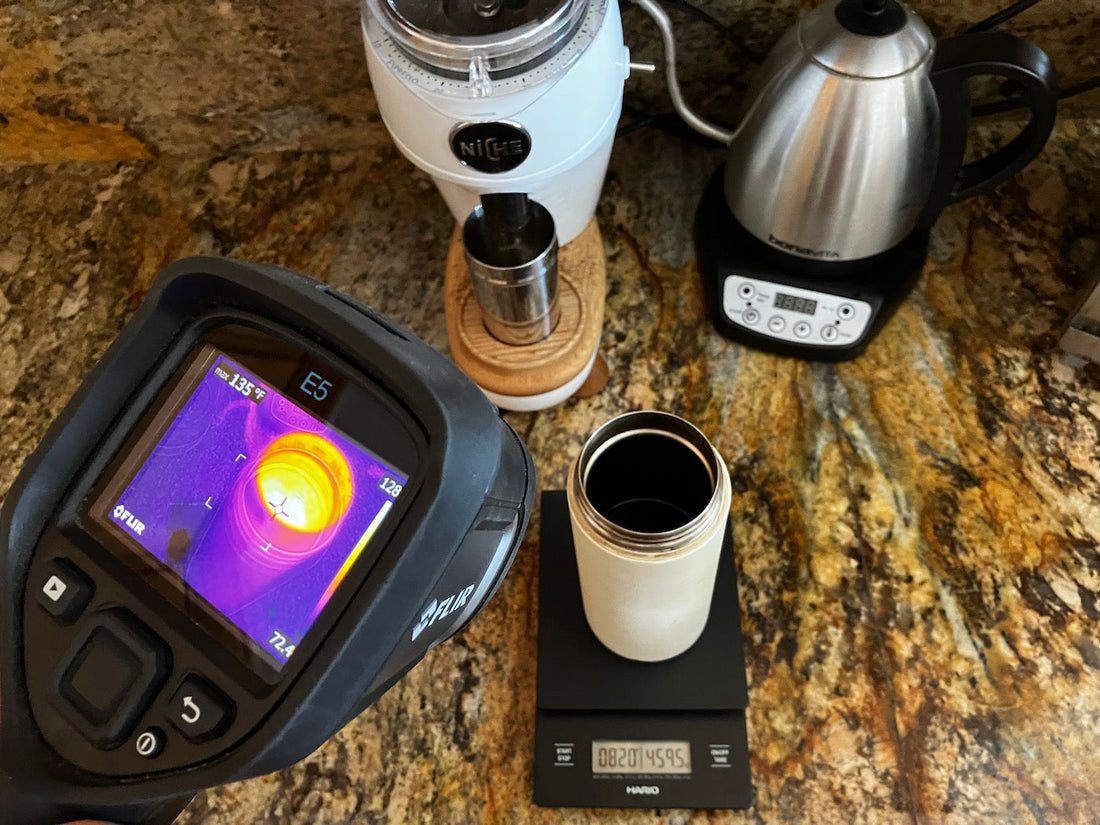
What’s the Best Coffee Temperature for Maximum Flavor?
Share
Most people sip their coffee as soon as it’s brewed, steaming hot and fresh from the kettle or machine. But here's the secret: you’re not getting the full flavor experience when it’s piping hot.
In fact, drinking coffee at the wrong temperature can mute flavor, distort aromas, and mask the complexity of the roast. So what’s the ideal drinking temperature for coffee? Let’s dig into the science and sensory experience to help you get the most from every cup.
Why Temperature Impacts Flavor
Coffee is a complex beverage with over 800 volatile compounds, many of which are highly sensitive to temperature. When the coffee is too hot, these compounds either evaporate too quickly or don’t fully open up. When it’s too cool, bitterness can take over, and the cup may taste flat.
The goal is to find the sweet spot, where flavor, aroma, and mouthfeel align to give you the best possible experience.
135°F is Our Favorite
Here at Frequent Coffee, we did our own blind tasting and then checked the temperature with a thermal imaging camera. We felt that 135°F was the point at which the coffee had the most flavor. Keep in mind, though, that it's a matter of personal preference. The only way to find your own preferred coffee temperature is to do a little experimentation yourself.

The Science-Backed Sweet Spot: 130°F to 160°F (54°C to 71°C)
According to sensory research and barista consensus, the optimal drinking temperature for coffee falls between 130°F and 160°F (54°C to 71°C). Here's what happens at different points in that range:
- 170°F+ (77°C+): Too hot to taste properly. You risk burning your tongue and muting complex flavor notes. The coffee will taste thinner and more bitter.
- 160–150°F (71–65°C): Still quite hot, but aromas begin to open up. Ideal for initial sips.
- 150–140°F (65–60°C): This is the golden zone for many. Acidity becomes more vibrant, sweetness increases, and nuanced flavors are easier to detect.
- 140–130°F (60–54°C): The sweet spot for balanced perception. Mouthfeel is fuller, and origin flavors shine.
- Below 130°F (54°C): Some flavors can become dull or overly acidic. Still drinkable, but past its peak flavor performance.

Hot vs. Warm: Why “Too Hot” Isn’t Better
When you sip coffee fresh off the brew, you’re essentially overwhelming your taste receptors. It’s the coffee equivalent of eating soup straight from the pot. You get heat, but very little nuance.
Letting your coffee cool for even a few minutes after brewing makes a world of difference. As it cools, the aromatic compounds stabilize, and your palate can actually perceive the subtle tasting notes, like citrus, berry, chocolate, or caramel, that the roaster worked hard to preserve.
Pro Tips to Taste More in Every Sip
- Wait 3–5 minutes after brewing: This brings most cups into the 140–150°F range naturally.
- Use a ceramic or double-wall glass mug: These retain heat while preventing overheating.
- Swirl before sipping: Helps distribute aroma and accelerate cooling just slightly.
- Try temperature testing: Taste the same brew at different intervals to find your personal flavor peak.
Does Roast Type Affect Ideal Temperature?
Yes. Lighter roasts tend to shine at slightly lower temperatures (135–145°F), where their fruity and floral notes are more detectable. Dark roasts often taste best around 145–155°F, where their body and chocolatey depth are still intact without being overly bitter.
Pro tip: If you're drinking decaf (especially Swiss Water® or Sugarcane processed like the ones offered here at Frequent Coffee), the flavor can peak a bit sooner due to the more delicate profile. Sip between 130–145°F for the best results.
Explore our decaf blends to taste the difference yourself.
Should You Reheat Coffee?
Short answer: Try not to. Reheating coffee (especially in the microwave) can cause a breakdown of acids and aromatic compounds, often resulting in a flat, bitter cup.
If you must reheat, do it slowly on the stovetop and never bring it to a boil. Better yet—store coffee in a vacuum-insulated container and sip as it naturally cools into the flavor sweet spot.
Final Thoughts: Taste More by Cooling Down
The next time you pour a cup, don’t rush it. Give your coffee a few minutes to cool, and you’ll discover new layers of flavor you never noticed before. That bold Ethiopian might taste like lemon zest. That mellow decaf? Maybe it has cocoa, toasted almonds, or molasses you hadn’t picked up on.
Good coffee deserves to be experienced at its best, not scalding hot. Take your time, taste thoughtfully, and enjoy the full spectrum in your mug.
Try our small-batch decaf coffees →
What’s Your Perfect Temperature?
Do you have a favorite sipping temperature? Have you tried tasting your coffee at different stages of cooling?
Share your thoughts or tag us on Instagram @frequent.coffee with your ideal flavor zone - we’d love to feature your brew ritual!
